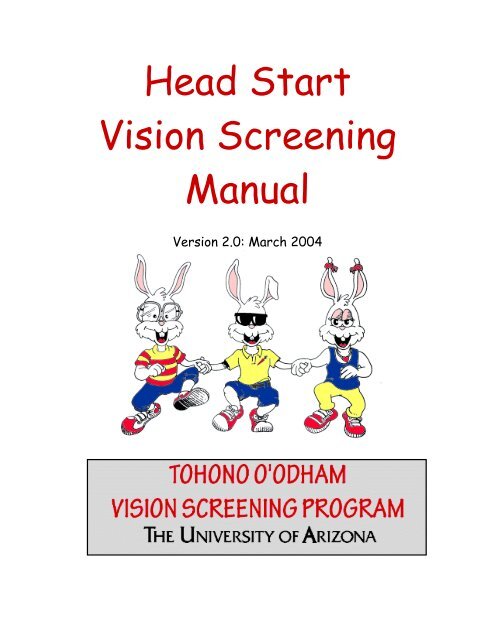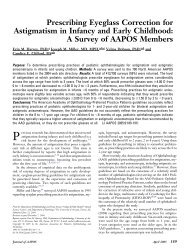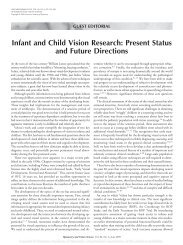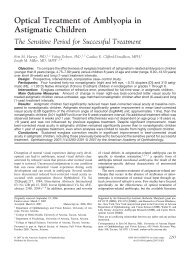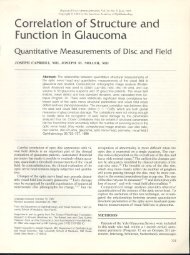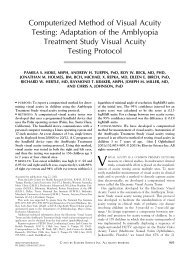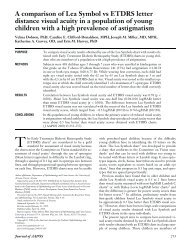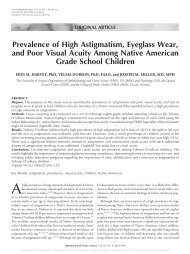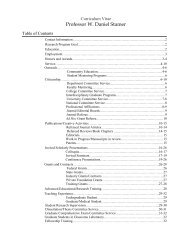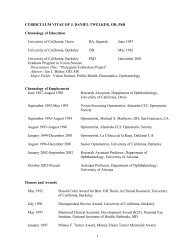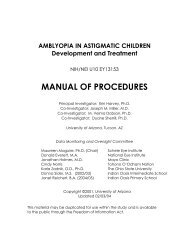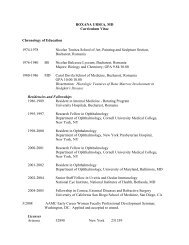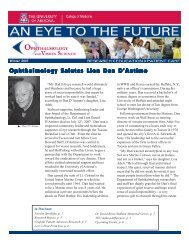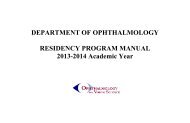Head Start Vision Screening Manual - University of Arizona
Head Start Vision Screening Manual - University of Arizona
Head Start Vision Screening Manual - University of Arizona
Create successful ePaper yourself
Turn your PDF publications into a flip-book with our unique Google optimized e-Paper software.
<strong>Head</strong> <strong>Start</strong><br />
<strong>Vision</strong> <strong>Screening</strong><br />
<strong>Manual</strong><br />
Version 2.0: March 2004
Page Section<br />
3 Introduction<br />
Contents<br />
5 Overview <strong>of</strong> the <strong>Vision</strong> <strong>Screening</strong><br />
Procedure<br />
6 <strong>Vision</strong> <strong>Screening</strong> Flow Chart<br />
7 Keratometry: Measuring the Eye for<br />
Astigmatism<br />
9 Visual Acuity: The Patti Pics Test<br />
11 Appendix A: Equipment Maintenance,<br />
Repair and Replacement<br />
12 Appendix B: <strong>Screening</strong> Instructions and<br />
Recording Sheets<br />
2
Introduction<br />
<strong>Vision</strong> Problems Among Tohono O’Odham Children<br />
Many Tohono O’Odham people, and people <strong>of</strong> other Native American Tribes, have an<br />
eye condition called astigmatism. Approximately one child in three requires glasses for<br />
astigmatism. We do not know why so many Tohono O’Odham children have<br />
astigmatism. However, doctors believe that if children do not get glasses for<br />
astigmatism when they are young (before age 8), they can develop a vision problem<br />
called amblyopia.<br />
To understand astigmatism and amblyopia, it is important to understand that your visual<br />
system is much more than just your eyes. Your brain is also very important in<br />
determining what you can see.<br />
Your eyes work much like a movie projector. Light enters your eyes, and an image <strong>of</strong><br />
what you are looking at is projected on the back <strong>of</strong> your eye (the retina), like a movie<br />
screen. The lens in your eye adjusts to try to focus the image on the back <strong>of</strong> your eye.<br />
Once the image is focused on the back <strong>of</strong> your eye, the brain takes over in the process<br />
<strong>of</strong> seeing. Nerves take the information from the back <strong>of</strong> your eye to the brain (the visual<br />
cortex), and your brain works to organize what you are seeing. Children with<br />
astigmatism have trouble focusing images on the back <strong>of</strong> their eye.<br />
What is Astigmatism?<br />
Astigmatism is a condition in which the front <strong>of</strong> the eye is more steeply curved in one<br />
direction than another. Instead <strong>of</strong> the front <strong>of</strong> the eye being round like a basketball, it is<br />
shaped like a football.<br />
A child with astigmatism does not see clearly at any distance – up close or far away.<br />
The image that the front <strong>of</strong> the eye projects on the back <strong>of</strong> the eye (the retina) is not in<br />
focus. If children with astigmatism do not wear glasses when they are young, they can<br />
develop amblyopia.<br />
What is Amblyopia?<br />
Amblyopia (sometimes called “lazy eye”) is poor vision that cannot be corrected with<br />
eyeglasses. For vision to develop correctly, young children need to see clearly. The<br />
image <strong>of</strong> what they are looking at must be focused clearly on the back <strong>of</strong> their eye. If<br />
the images are not focused clearly, the visual part <strong>of</strong> the brain does not develop the way<br />
it should.<br />
Children with poor vision who do not wear glasses while their vision is still developing<br />
can develop amblyopia, or poor vision that cannot be corrected with eyeglasses.<br />
Children with astigmatism cannot focus things clearly. They are at risk for developing<br />
amblyopia.<br />
3
What can we do to assure that the children do not develop amblyopia?<br />
If children with astigmatism get eyeglasses when they are young, and wear them, there<br />
is a good chance that they will not develop amblyopia. It is important to determine if any<br />
<strong>of</strong> the young children have astigmatism, so that they can be referred to an eye doctor,<br />
and get eyeglasses if necessary.<br />
The Tohono O’Odham <strong>Vision</strong> <strong>Screening</strong> Program.<br />
From 1997 to 2001, the Tohono O’Odham Nation and the <strong>University</strong> <strong>of</strong> <strong>Arizona</strong><br />
sponsored The Tohono O’Odham <strong>Vision</strong> <strong>Screening</strong> Program. All children enrolled in<br />
the Tohono O’Odham <strong>Head</strong> <strong>Start</strong> program were eligible to receive free eye<br />
examinations and free eyeglasses (if they required them) through the program.<br />
One <strong>of</strong> the goals <strong>of</strong> the program was to determine the best screening method for<br />
determining which children were likely to require eyeglasses and therefore should<br />
receive an eye examination. Once an effective method was determined, the plan was<br />
to implement a screening program that would allow <strong>Head</strong> <strong>Start</strong> staff to screen all <strong>of</strong> the<br />
children, and to refer for eye examinations only the children who “failed” the screening.<br />
4
Overview <strong>of</strong> the <strong>Vision</strong> <strong>Screening</strong> Procedure<br />
The screening method described in this manual is recommended by the Tohono<br />
O’Odham <strong>Vision</strong> <strong>Screening</strong> Program for screening <strong>of</strong> Tohono O’Odham <strong>Head</strong> <strong>Start</strong><br />
children. The screening consists <strong>of</strong> two components: Keratometry and Visual Acuity<br />
<strong>Screening</strong>. Keratometry measures the curvature <strong>of</strong> the surface <strong>of</strong> the eye (without<br />
touching the eye) and provides a measure <strong>of</strong> amount <strong>of</strong> astigmatism. Visual acuity<br />
screening measures how well the child can see fine detail.<br />
Children who meet the following criteria should be referred to an ophthalmologist<br />
or optometrist for a complete eye examinations:<br />
1. Children who fail the Keratometry screening described in this manual.<br />
2. Children who fail the visual acuity screening and rescreening described in this<br />
manual.<br />
3. Children identified by the <strong>Head</strong> <strong>Start</strong> program as having “special needs”.<br />
4. Children who complain about poor vision.<br />
5. Children who appear to have crossed eyes or an eye that turns outward.<br />
6. Children who have a droopy eyelid that partially covers the pupil (the center<br />
black portion <strong>of</strong> the eye) when the eye is open.<br />
5
<strong>Vision</strong> <strong>Screening</strong> Flow Chart<br />
Begin with Keratometry <strong>Screening</strong><br />
Pass Keratometry<br />
Continue with Visual Acuity<br />
<strong>Screening</strong><br />
Fail Acuity <strong>Screening</strong><br />
Re-screen later<br />
6<br />
Fail Keratometry<br />
STOP, Refer to eye doctor for<br />
exam. <strong>Screening</strong> completed<br />
Pass Acuity <strong>Screening</strong><br />
No referral necessary<br />
<strong>Screening</strong> completed<br />
Pass Acuity Re-screening<br />
No referral necessary<br />
<strong>Screening</strong> completed<br />
Fail Acuity Re-screening<br />
Refer to eye doctor for exam.<br />
<strong>Screening</strong> completed.
Keratometry: Measuring the Eye for Astigmatism<br />
a. Equipment<br />
• Nidek KM-500 Keratometer<br />
• A chair for the tester and a chair for<br />
the child<br />
• A darkened quiet room<br />
b. Setting Up<br />
• Set up the instrument on a<br />
table near an electrical outlet. The<br />
instrument setup is illustrated to the<br />
right. Please note that the cables<br />
should be set up specifically as<br />
illustrated, or the instrument will not<br />
work.<br />
• Set up two chairs facing each<br />
other, one for the tester and one for the<br />
child, next to the table.<br />
c. Procedure<br />
(1) Have the child sit in a chair with his/her back against the backrest.<br />
(2) The tester should sit in a chair in front <strong>of</strong> and facing the child.<br />
(3) To turn on the Keratometer, press ‘R’. This also sets the instrument for<br />
measurement <strong>of</strong> the right eye.<br />
(4) Tell the child that all they have to do is to look in the little hole in front <strong>of</strong> the<br />
Keratometer and look right at the red dot.<br />
(5) Align the Keratometer in front <strong>of</strong> the child’s right eye, and then look through the<br />
viewer. Center the red ring over the pupil (the center black portion <strong>of</strong> the eye) and<br />
adjust the distance so that the target ring is clear and in focus. As the ring is brought<br />
closer to focus, it will blink more rapidly. After a measurement has been successfully<br />
made, the instrument will make a chirping sound. It may help to place your free hand<br />
on top <strong>of</strong> the child’s head, to reduce movement.<br />
(6) Encourage the child to keep looking in the red dot. It may help to tell them ‘if you<br />
keep looking at the dot, the machine will make a chirping sound, like a little bird.. so see<br />
if you can make the machine chirp’.<br />
7
(7) When right eye measurement is<br />
complete, press the “L” to set the instrument<br />
left eye measurement. Proceed with<br />
measurement <strong>of</strong> the left eye.<br />
(8) Once you have measured both eyes,<br />
aim the keratometer at the printer (with the<br />
buttons toward you, and the measurement<br />
side facing the printer), and press the button<br />
to print the child’s results (the print button is<br />
the oval shaped button on the left).<br />
Note: the part <strong>of</strong> the keratometer that sends<br />
the measurement to the printer is on the bottom portion <strong>of</strong> the instrument handle, just<br />
above the four silver bars. Be sure that you are not covering this part <strong>of</strong> the instrument<br />
when you send the measurement to the printer.<br />
(9) Turn <strong>of</strong>f the Nidek to clear the measurements for the next child (the <strong>of</strong>f button is<br />
the oval shaped button on the right.<br />
c. Data Sheet (Appendix B)<br />
Attach the Keratometer printout with tape to the child’s Keratometry score sheet.<br />
Note: When taping the printout, be sure that the tape does not cover any <strong>of</strong> the<br />
numbers. The paper used is heat sensitive, and placing tape over the numbers will<br />
make them disappear.<br />
d. Keratometer maintenance and battery charging<br />
See Manufacturer’s <strong>Manual</strong>.<br />
8
a. Equipment<br />
Visual Acuity: The Patti Pics Test<br />
• Patti Pics test book (20/80 and 20/63)<br />
• Patti Pics lap card<br />
• Patti Pics pretest flip cards<br />
• Measuring tape that is at least 10 feet long.<br />
• Chair for the child and a chair for the tester.<br />
• Eye patching tape<br />
• Well lit quiet room for testing<br />
b. Setting Up<br />
• Set up the chairs so that the tester’s and child’s chairs are 10 feet apart, facing<br />
each other. The chairs should be set up so that, when the child and the testers are<br />
each sitting in their chairs, the test card is held 10 feet from the child’s eyes.<br />
c. Conducting the Test<br />
(1) Have the child sit in the chair facing the tester’s<br />
chair.<br />
(2) If children come to the test session wearing<br />
glasses, test their acuity with the glasses on, and<br />
make a notation on the scoring sheet that the child<br />
was tested “with glasses on”.<br />
(3) Place the lap card on the child’s lap, or have an<br />
assistant (teacher/parent) hold the card in front <strong>of</strong> the<br />
child.<br />
(4) Explain to the child that they will be playing a<br />
matching game. You will show them a picture, and<br />
their job is to point the same picture on the card.<br />
(5) Pretest: The tester will hold the flip card 1-2 feet<br />
in front <strong>of</strong> the child, and present each <strong>of</strong> the 4<br />
symbols. For each symbol, the tester will ask the child<br />
to point to the picture on their card that looks like that<br />
picture.<br />
For older and more verbal children, the tester may ask the child what the picture<br />
looks like. If the child is able to identify each picture easily and consistently, the test<br />
may be done without the lap card. However, sometimes children who can identify large<br />
symbols verbally do better if they use the lap card when the symbols get smaller.<br />
If the child is unable to identify the symbols on the pretest, testing is completed<br />
and the tester should record “unable to test” on the child’s acuity score sheet.<br />
9
(6) The right eye should be tested first, and then the left eye should be tested. After<br />
the pretest with the flip cards is completed satisfactorily, the tester should put a patch<br />
over the left eye (micropore tape). The tester should explain that the patch does not<br />
hurt at all, and that we want to test what one eye can see all by itself.<br />
(7) The tester will sit in the chair opposite the child, and 10 feet away. Hold the<br />
20/80 card for the right eye in front <strong>of</strong> yourself so the child can see it.<br />
(8) The tester will begin with the symbol to the (child’s) left, and asks the child to<br />
identify each <strong>of</strong> the symbols from left to right. If the child is unable to identify at least 3<br />
<strong>of</strong> the 5 symbols on the 20/80 card, acuity is scored as “worse than 20/80”, and the child<br />
“fails” the acuity screening.<br />
If the child correctly identifies at least 3 symbols on the 20/80 card, the tester will<br />
continue with the 20/63 card for the right eye and ask the child to identify the symbols<br />
from left to right. If the child incorrectly identifies 3 symbols on the 20/63 card, acuity is<br />
scored as the “20/63 or better”, the child “passes” acuity screening for that eye, and<br />
testing <strong>of</strong> that eye is completed. If the child is unable to identify at least 3 symbols on<br />
the 20/63 card, acuity is scored as “worse than 20/63”, the child “fails” the acuity<br />
screening, and acuity testing for that eye is completed.<br />
(9) Record the results for the right eye, patch the right eye, and proceed with testing<br />
<strong>of</strong> the left eye using the 20/80 for the left eye and then the 20/63 card for the left eye.<br />
Be sure to record all results before you begin testing the next child.<br />
Summary: The child who can identify at least 3 out <strong>of</strong> 5 symbols on the 20/63 card for<br />
both eyes “passes” the acuity screening. All other children (children who are unable to<br />
test, who can not identify at least 3 symbols on the 20/80 card, or children who can not<br />
identify at least 3 symbols on the 20/63 card) “fail” the acuity screening.<br />
d. Helpful Hints<br />
(1) Encourage and praise the child for identifying a symbol, even if it is incorrect (it is<br />
possible that the child is doing his/her best, but is unable to see the symbol clearly).<br />
Avoid telling the child that he or she is are correct, just say things like “good job!” and<br />
“that’s the way to play!”.<br />
(2) If, during the test, the tester senses that the child is getting bored, and is<br />
incorrectly identifying letters due to inattention, have the child identify the symbols on<br />
the pretest card again. If the child correctly re-identifies the symbols, he or she may<br />
appeared bored on the smaller symbols because he or she is having trouble seeing<br />
them. If their attention is so poor that they can no longer identify the symbols using the<br />
pretest card, attempts to re-engage the child in the task must be undertaken.<br />
(3) Some techniques for re-engaging attention:<br />
• Ask the child to YELL out the name <strong>of</strong> the picture, as loud as possible!<br />
• Enlist the help <strong>of</strong> an assistant to hold the card, and to keep directing the child’s<br />
attention to the task.<br />
10
Appendix A:<br />
Equipment Maintenance, Repair and Replacement<br />
Visual Acuity Testing Equipment<br />
• Acuity cards should be cleaned with non-abrasive sponges, towels, or wet wipes (Wet-<br />
Ones, or Wash ‘n Dry). If the lettering on the 20/50 or 20/80 cards becomes scratched<br />
or damaged, the cards should be replaced. Patti Pics Equipment can be purchased<br />
from the manufacturer:<br />
Precision <strong>Vision</strong>, Inc.<br />
944 First Street<br />
La Salle, IL 61301<br />
800-772-9211<br />
precisionvision@mindspring.com<br />
www.precision-vision.com<br />
Item # Name Description<br />
2590 MassVAT Visual Acuity Test Patti Pics Distance screening test book<br />
Training card replacements Patti Pics Pre-test cards<br />
Response Key replacements Patti Pics Child’s lap card<br />
• Tape measure can be purchased from any hardware store. Be sure to purchase one<br />
that is at least 10 feel long.<br />
• The tape that we use for eye patching is 3M micropore hypoallergenic surgical tape, 2<br />
inches x 10 yards. This tape is sticky enough to stay on the child’s skin during testing,<br />
but not so sticky that it will hurt when it is pulled <strong>of</strong>f.<br />
• The Keratometer (Marco/Nidek KM500) and printer can be purchased from Opthalmic<br />
Instrument Companies. Information on companies that sell the KM500 can be obtained<br />
by contacting the manufacturer at :<br />
Marco<br />
1-800-874-5274<br />
11825 Central Parkway<br />
Jacksonville, Florida 32224<br />
www.marcooph.com<br />
• Replacement printer paper for the Keratometer can be purchased from <strong>of</strong>fice supply<br />
stores. You should purchase thermal calculator rolls, size 2 & 1/4 inch x 85 feet.<br />
11
Appendix B:<br />
<strong>Screening</strong> Instruction and Recording Sheets<br />
The following pages contain sheets for recording and scoring screening results.<br />
These sheets should be photocopied, and a new sheet should be used for each child<br />
screened.<br />
(1) Keratometry <strong>Screening</strong><br />
(2) Visual Acuity <strong>Screening</strong><br />
(3) Visual Acuity Re-<strong>Screening</strong><br />
12
First Name:_______________________ Classroom:_______________________<br />
Last Name:_______________________ Date Screened: ___________________<br />
Date <strong>of</strong> Birth:_________________ Screener’s Name: __________________<br />
Tohono O’Odham <strong>Head</strong> <strong>Start</strong><br />
<strong>Vision</strong> <strong>Screening</strong> - Keratometry<br />
Keratometry<br />
(Tape Printout Here)<br />
Is right eye CYL 2.25 or greater?<br />
Yes ► STOP, refer to eye doctor.<br />
No ► Continue with left eye keratometry evaluation.<br />
Unable to measure right eye ► STOP, refer to eye doctor.<br />
Is left eye CYL 2.25 or greater?<br />
Yes ► STOP, refer to eye doctor.<br />
No ► Continue with acuity evaluation.<br />
Unable to measure left eye ► STOP, refer to eye doctor.<br />
13
First Name:_______________________ Classroom:_______________________<br />
Last Name:_______________________ Date Screened: ___________________<br />
Date <strong>of</strong> Birth:_________________ Screener’s Name: __________________<br />
Tohono O’Odham <strong>Head</strong> <strong>Start</strong><br />
<strong>Vision</strong> <strong>Screening</strong> – Visual Acuity<br />
Is the child wearing eyeglasses?<br />
(circle one)<br />
Yes ► Test with glasses on No►Continue<br />
Pretest (do not use patch)<br />
(1) Can the child identify all 4 symbols?<br />
Yes ► Continue No ► Re-screen later<br />
Right Eye (patch left eye)<br />
(2) 20/80 line: Number <strong>of</strong> symbols correct:<br />
1 2 3 4 5<br />
(3) 20/63 line: Number <strong>of</strong> symbols correct:<br />
1 2 3 4 5<br />
Left Eye (patch right eye)<br />
(4) 20/80 line: Number <strong>of</strong> symbols correct:<br />
1 2 3 4 5<br />
(5) 20/63 line: Number <strong>of</strong> symbols correct:<br />
1 2 3 4 5<br />
Right Eye Acuity<br />
Was child able to identify 3 or more symbols on the 20/63 line?<br />
Yes ► Pass, do not re-screen.<br />
No ► Re-screen later<br />
Unable to test ► Re-screen later<br />
Left Eye Acuity<br />
Was child able to identify at least 3 symbols on the 20/63 line?<br />
Yes ► Pass, do not re-screen.<br />
No ► Re-screen later<br />
Unable to test ► Re-screen later<br />
14
First Name:_______________________ Classroom:_______________________<br />
Last Name:_______________________ Date Screened: ___________________<br />
Date <strong>of</strong> Birth:_________________ Screener’s Name: __________________<br />
Tohono O’Odham <strong>Head</strong> <strong>Start</strong><br />
<strong>Vision</strong> <strong>Screening</strong> – Visual Acuity Re-Screen<br />
Is the child wearing eyeglasses?<br />
(circle one)<br />
Yes ► Test with glasses on No►Continue<br />
Pretest (do not use patch)<br />
(1) Can the child identify all 4 symbols?<br />
Yes ► Continue No ► Re-screen later<br />
Right Eye (patch left eye)<br />
(2) 20/80 line: Number <strong>of</strong> symbols correct:<br />
1 2 3 4 5<br />
(3) 20/63 line: Number <strong>of</strong> symbols correct:<br />
1 2 3 4 5<br />
Left Eye (patch right eye)<br />
(4) 20/80 line: Number <strong>of</strong> symbols correct:<br />
1 2 3 4 5<br />
(5) 20/63 line: Number <strong>of</strong> symbols correct:<br />
Right Eye Acuity<br />
Was child able to identify 3 or more symbols on the 20/63 line?<br />
Yes ► Pass .<br />
No ► STOP, refer to eye doctor.<br />
Left Eye Acuity<br />
Was child able to identify 3 or more symbols on the 20/63 line?<br />
Yes ► Pass.<br />
No ► STOP, refer to eye doctor.<br />
15
For more information, please contact:<br />
The Tohono O’Odham <strong>Vision</strong> <strong>Screening</strong> Program<br />
The <strong>University</strong> <strong>of</strong> <strong>Arizona</strong><br />
Department <strong>of</strong> Ophthalmology and <strong>Vision</strong> Science<br />
655 N. Alvernon Way, Suite 108<br />
Tucson, AZ 85711<br />
In Sells: 520/383-6207<br />
In Tucson: 520/324-3162<br />
Joseph M. Miller, M.D., M.P.H., Medical Director<br />
Erin Harvey, Ph.D., Director<br />
Velma Dobson, Ph.D., Co-Director<br />
Frances Lopez, Registrar<br />
Irene Adams, <strong>Vision</strong> <strong>Screening</strong> Technician<br />
Candice Clifford, <strong>Vision</strong> <strong>Screening</strong> Technician<br />
Pat Broyles, Administrative Assistant<br />
Sponsored by:<br />
The Tohono O’odham Nation<br />
and<br />
Funded by:<br />
16


